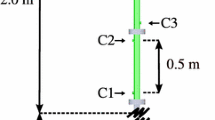Abstract
The influence of transverse concentration gradients on detonation propagation in \(\hbox {H}_2\)–air mixtures is investigated experimentally in a wide parameter range. Detonation fronts are characterized by means of high-speed shadowgraphy, OH* imaging, pressure measurements, and soot foils. Steep concentration gradients at low average \(\hbox {H}_2\) concentrations lead to single-headed detonations. A maximum velocity deficit compared to the Chapman–Jouguet velocity of 9 % is observed. Significant amounts of mixture seem to be consumed by turbulent deflagration behind the leading detonation. Wall pressure measurements show high local pressure peaks due to strong transverse waves caused by the concentration gradients. Higher average \(\hbox {H}_2\) concentrations or weaker gradients allow for multi-headed detonation propagation.

















Similar content being viewed by others
References
Kotchourko, A.: Hydrogen safety research priorities. In: International Conference on Hydrogen Safety (ICHS), Brussels, (2013)
Breitung, W., Chan, C.K., Dorofeev, S.B., Eder, A., Gerland, B., Heitsch, M., Klein, R., Malliakos, A., Shepherd, J.E., Studer, E., Thibault, P.: Flame acceleration and deflagration-to-detonation transition in nuclear safety. Technical report, OECD State-of-the-Art Report by a Group of Experts, NEA/CSNI/R(2000)7, (2000)
Ishii, K., Kojima, M.: Behavior of detonation propagation in mixtures with concentration gradients. Shock Waves 17, 95–102 (2007)
Ettner, F., Vollmer, K.G., Sattelmayer, T.: Mach reflection in detonations propagating through a gas with a concentration gradient. Shock Waves 23, 201–206 (2012)
Kessler, D., Gamezo, V., Oran, E.: Gas-phase detonation propagation in mixture composition gradients. Philos. Trans. R. Soc. A 370, 567–596 (2012)
Calhoon, W.H., Sinha, N.: Detonation wave propagation in concentration gradients. In: Proc. 43rd AIAA Aerospace Sciences Meeting and Exhibit, Reno, Nevada (2005)
Dabora, E.K., Nicholls, J.A., Morrison, R.B.: The influence of a compressible boundary on the propagation of gaseous detonations. In: Symposium (International) on Combustion, vol. 10, pp. 817–830. Elsevier (1965)
Oran, E.S., Jones, D., Sichel, M.: Numerical simulations of detonation transmission. Proc. R. Soc. A 436, 267–297 (1992)
Liu, J.C., Sichel, M., Kaufmann, C.W.: The lateral interaction of detonating and detonable gaseous mixtures. Prog. Astronaut. Aeronaut. 114, 264–283 (1988)
Tonello, N.A., Sichel, M., Kaufmann, C.W.: Mechanisms of detonation transmission in layered H2–O2 mixtures. Shock Waves 5, 225–238 (1995)
Lieberman, D.H., Shepherd, J.E.: Detonation interaction with a diffuse interface and subsequent chemical reaction. Shock Waves 16, 421–429 (2007)
Rudy, W., Kuznetsov, M.S., Porowski, R., Teodorczyk, A., Grune, J., Sempert, K.: Critical conditions of hydrogen-air detonation in partially confined geometry. Proc. Combust. Inst. 34, 1965–1972 (2013)
Gaathaug, A.V., Vaagsaether, K., Bjerketvedt, D.: Detonation propagation in a reactive layer: the role of detonation front stability. In: Proceedings of the 10th International Symposium on Hazards, Prevention and Mitigation of Industrial Explosions, Bergen, Norway (2014)
Boeck, L.R., Msalmi, M., Koehler, F., Hasslberger, J., Sattelmayer, T.: Criteria for DDT in hydrogen-air mixtures with concentration gradients. In: 10th International Symposium on Hazards, Prevention and Mitigation of Industrial Explosions, Bergen, Norway (2014)
Boeck, L.R.: Deflagration-to-detonation transition and detonation propagation in H2-air mixtures with transverse concentration gradients. PhD thesis. Lehrstuhl für Thermodynamik, Technische Universität München (2015)
Ettner, F.: Effiziente Numerische Simulation des Deflagrations-Detonations-Übergangs. PhD Thesis, Technische Universität München (2013)
Vollmer, K.G., Ettner, F., Sattelmayer, T.: Deflagration-to-detonation transition in hydrogen-air mixtures with a concentration gradient. Combust. Sci. Technol. 184, 1903–1915 (2012)
Vollmer, K.G.: Einfluss von Mischungsgradienten auf die Flammenbeschleunigung und die Detonation in Kanälen. PhD Thesis, Lehrstuhl für Thermodynamik, Technische Universität München (2015)
Fiala, T., Sattelmayer, T.: A posteriori computation of OH* radiation from numerical simulations in rocket combustion chambers. In: 5th European Conference for Aeronautics and Space Sciences (EUCASS), Munich, (2013)
Kaneshige, M., Shepherd, J.E.: Detonation database. Technical Report FM97-8, GALCIT (1997)
Acknowledgments
The presented work is funded by the German Federal Ministry of Economic Affairs and Energy (BMWi) on the basis of a decision by the German Bundestag (Project Nos. 1501338 and 1501425) which is gratefully acknowledged.
Author information
Authors and Affiliations
Corresponding author
Additional information
Communicated by N. Smirnov and A. Higgins.
Rights and permissions
About this article
Cite this article
Boeck, L.R., Berger, F.M., Hasslberger, J. et al. Detonation propagation in hydrogen–air mixtures with transverse concentration gradients. Shock Waves 26, 181–192 (2016). https://doi.org/10.1007/s00193-015-0598-8
Received:
Revised:
Accepted:
Published:
Issue Date:
DOI: https://doi.org/10.1007/s00193-015-0598-8




